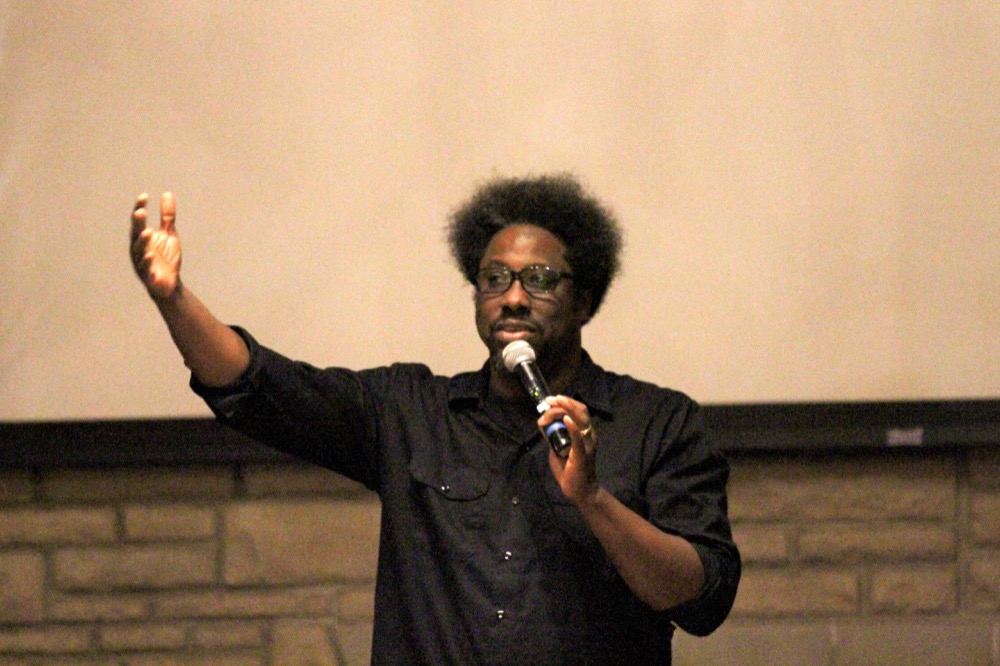Campus Events
Comedian, CNN host talks about race through humor in CS40 speech
College Hall was almost entirely filled as W. Kamau Bell, a socio-political comedian and host of CNN’s “United Shades of America,” delivered a talk on racism Wednesday night. Right away, Bell warned the audience that the talk was not going to be comfortable or filled with race buzzwords.
The title slide was up on the screen before Bell began speaking. It read “The W. Kamau Bell Curve.” The first time he hit the clicker, a small subtitle popped up that said, “Ending Racism in about an hour.”
 Jordan Chow | Student Life
Jordan Chow | Student Life W. Kamau Bell speaks to the audience gathered inside College Hall on Wednesday, Oct., 26. The political comedian was brought to campus by Congress of the South 40.
Over the course of the talk, Bell showed a video of his stand-up, in which he said that we could never have a black president named Barack Obama; made fun of himself—and the audience—by saying “Boy is my face brown;” and addressed the recent Snapchat screenshot that sparked backlash on Facebook last weekend, saying that all he had to do was google “Wash. U. racism.”
His next slide asked the audience when they thought it was OK to use blackface—giving them three options: “Never,” “F—— Never” and “When your face is actually black.”
“Use your own face,” Bell said.
Bell went on to discuss how small ways to talk about racism are needed so that they can build towards larger conversations. He mentioned how racism is not in your face like it used to be, but is still easy to find. He showed an example of a Red Cross infographic of acceptable behaviors around a pool. Almost all of the bad behaviors were done by black people and all of the good behaviors were done by white people.
Bell also discussed racism in sports stressing its political nature.
Specifically, he showed a picture of football player Colin Kaepernick with short hair, then one with his afro as he proclaimed to laughter, “This dudes been reading ‘Between the World and Me’ with that afro.”
He also discussed basketball player Jeremy Lin, and much of the racism that surrounded his rise and fall, including an ESPN article titled “C—- in the Armor.”
Next was sports teams’ names, most prominently the Cleveland Indians, a team currently in contention for the World Series.
“We still name sports teams after races of people, that’s crazy, think about that, if the Indians win the World Series, people will be like ‘Yay, the Indians won! The Indians won!’ Did the Indians win?” he said.
During the question and answer section, one student asked about what comedians can and can’t say.
“People make a big deal about comedians being able to say whatever…every comedian has a line,” Bell said.
Another student asked what he thought comedians impact is on the public and if they can cause change.
“Dave Chappelle is not Barack Obama, but I’m not sure you get Barack Obama without David Chappelle,” Bell said.
Freshman attendee Ben Ushman said that Bell addressed issues that are important to the larger community today.
“I thought these were the questions that had to be raised,” Ushman said. “I think it was definitely a meaningful conversation.”
Another freshman attendee Jessie Rich expressed that she thought the overall talk was great, but took issue with a specific moment when Bell said that curiosity is not always OK.
“I disagreed with was the fact that he said curiosity is a bad thing when you’re wondering about other people’s races because you’re not going to learn about other cultures if you’re not curious,” Rich said. “I feel like most people are wanting to share about their culture and you should not be afraid to ask. But you have to ask the right questions.”
Senior David Gumins thought that, overall, the talk was one of the best the CS40 has had in his time at the University.
“One of the most engaging, one of the funniest, and someone who really understood the Wash. U. crowd. It didn’t feel like you had someone up on a pedestal sharing their story with us, he was someone trying to get on our level, and having a conversation with us,” Gumins said. “It was not just ‘oh its really cool I got to see this person,’ but it was the start of a conversation and a dialogue.”
